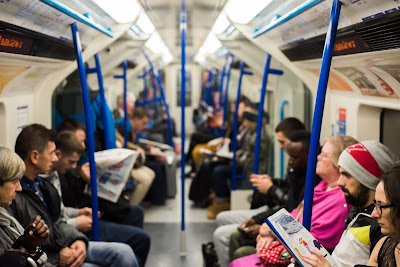Greg Yiangou - Consultant
With
millions of people depending on London's transport network, just how ‘smart’ is
it? Comparisons are often drawn between Singapore’s tube network or the ease of
cycling in Amsterdam, but every city faces its own pressures, needs and
challenges.
London has built an extensive, well developed network that runs
throughout the city, moving millions of people every day whilst representing a
sense of identity that is unique to the city. Red busses and black cabs are
synonymous with London and can be recognised all over the world. But as
London’s population rapidly grows, these networks are quickly reaching full
capacity, with commuters feeling the effects. Frustration grows as the quality
of public transport services often does not reflect the increasing costs
commuters have to pay.
‘London
Underground’
If you were to ask Londoners what they thought of the Underground, many
of the responses will be influenced by the recent tube strikes across the
entire network, which at times brought the city to its knees. They will point
to the daily struggle they face to squeeze onto a Northern Line train at 8am.
The image of commuters packing onto full tubes, narrowly missing the closing
doors is all too common during the morning and evening commutes.
London Underground handles 24.3 million passenger journeys every week,
with 1.2 billion journeys made in 2014. With London’s population expected to
top 10 million by 2030, there is no doubt the stress on the underground system
will increase. We expect a delay free service but realistically it is not yet
possible; the system is operating intensively at capacity and a single
interruption can quickly create a domino effect of delays and congestion.

Much of the growth in London will be seen in the suburbs, with commuters
still travelling into the city to work. Projects are under-way to manage this
growth, Crossrail being the largest. It is expected to become operational by
2018, increasing London’s rail-based capacity by 10%. But why stop there? The
construction of Crossrail 2 is looking increasingly likely.
But there is no denying
that these large infrastructure projects cost a lot of money. Is there a more
affordable solution? How can we increase capacity? Would automating the tube
improve the traveller’s experience? Should we be easing the pressure on the
tube by making other modes of transport in the city more attractive?
When we think about Smart we often think about technology but Smart
Solutions are about better understanding our infrastructure and utilising it in
more efficient and often more joined up ways. A Smart transport network should
facilitate the easy and efficient transition across various modes of transport.
TfL has started to think about rail as a supplementary link to the Tube. They
recently took control of the West Anglia route that runs from Liverpool Street
to north & east London and as far as Cheshunt, with the line now running under
a concession as opposed to a complex rail franchise, resulting in more trains,
refurbished stations and an increased capacity.
But
why not Cycle?
Vast numbers of commuters are braving the roads instead of facing the
tube. Cycle use grew by 10% in London over 2014 and is expected to grow by a
further 12% this year. 2014 also saw a record number of ‘Boris Bikes’ hired
from London’s cycle hire scheme, with more than 10 million journeys made. But
why are commuters taking to the streets? Is London’s cycle network getting
smarter or are these commuters just fed up of being squashed against a tube
door?
I think the increase is currently a result of ‘push’ factors as opposed
to a smart and safe cycle network. Overcrowding on the tubes, increased costs
of public transport and the high levels of road congestion are making cycling a
more attractive option in the city.
TfL’s bike sharing scheme, coupled with an extensive network of docking
stations has fuelled this growth in cycling. Technology is also playing its
part; smart apps that provide real-time information on their availability and
efficient cycle routes are available, but not enough has been done to date to
improve the safety of cycling which still accounts for 20% of road casualties
in London.
It is clear that cycling is
becoming an integral part of London’s transport network however, reflected by
its level of investment. The Greater London Authority’s Vision for Cycling
outlines plans for a £913 million programme to improve the cycling
infrastructure and safety for cyclists. This includes the flagship development
of the east to west super cycle highway.
Congested
Roads
London undoubtedly loses IQ points for its congested and polluted roads.
Many areas within the city are failing to meet the EU safe air quality
standards and with manufacturers such as VW cheating their emission tests, we
can see why progress has not been as strong as expected. This problem is
captured by the fact that Oxford Street, one of Europe’s most famous roads, is
now considered one of Europe’s most polluted roads. A recent study by King’s
College London (commissioned by the GLA) has put a very human figure to this
problem and estimates that air quality is annually responsible for
approximately 9,500 premature deaths in London. The seriousness of this problem
cannot be overlooked; London was named the most congested city in Europe last
August, with motorists spending on average 4 days per year in traffic.

There are alternatives; despite the controversy surrounding its use,
Uber is seamlessly connecting commuters to drivers, rivalling London’s Black
Cabs. Car clubs, such as Zipcar, are providing ‘wheels when you want them’ and
not wheels parked on the street for 90% of the time and TfL are now operating a
number of Hydrogen Buses in the city. I suppose the key question is why does
anyone need to drive in central London? Is the complete restriction of public
petrol or diesel vehicles in busy, central parts of London really such a
radical solution when we have one of the best public transport networks in the
world?
Open
Data
One area of the transport sector that London is leading on, and
definitely worth mentioning, is the availability of open data, which is
encouraging the creation of innovative ways of presenting, visualising and
using data to improve the commuting experience. A classic example is the
popular Citymapper app, now a global journey planning application, originally
designed in London. It brings together real-time route data for various modes
of transport to provide users with the real-time information they need to make
the best travel decisions. This is just one example of many and as access to
data increases, we are likely to see more and more advancements; just look at
the London Data Store.
There are clearly a lot of problems with London’s transport network, but
the city is definitely moving in the right direction. The Smart London Plan
recognises there is a need to understand how these smart technical solutions
and services can help improve the management of London’s transport networks. We
are going to be seeing big changes in our transport network over the coming
years. Hopefully they allow us to enjoy a stress free, spacious and healthy
commute in the mornings, but only time will tell.
Next Blog: Testing the IQ of our City - Test 2: Digital London
















